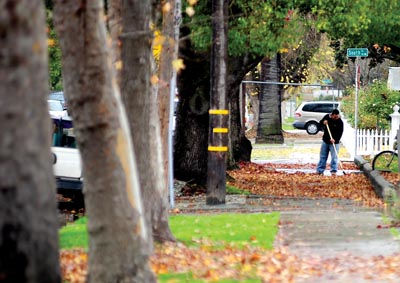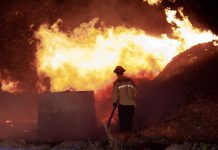The first of two storm fronts expected within a week dropped
about 1.5 inches of rain on the Hollister area, while showers
should be more isolated throughout the week, according to the
Monterey office of the National Weather Service.
The first of two storm fronts expected within a week dropped about 1.5 inches of rain on the Hollister area, while showers should be more isolated throughout the week, according to the Monterey office of the National Weather Service.
The first arrived in San Benito County Friday and lasted through Sunday. Through 4 p.m. Sunday, there had been 1.46 inches of rain here, while Monday’s totals were unavailable at the time of publication.
After some light rain Monday, more isolated storms are expected Tuesday, with another front moving in Tuesday night and staying into Wednesday, according to a meteorologist with the weather service. Showers should be isolated Thursday and Friday, with yet another storm expected on Christmas Day.
San Benito County Public Works crews by this past Friday had flooding signs at the ready and had restocked their supply of sandbags, 10 of which are available to each residence at 3220 Southside Road, according to Armand Nazemi.
While county workers are watching for erosion due to landslides during the storms, city utilities worker Ray Rojas said crews spent Thursday clearing leaves from gutters and storm drains in order to prevent street flooding.
Meteorologist Daniel Harty said the weather pattern is of some concern because of the predicted repeated impulses of rain.
“We’re kind of in a stagnant pattern of a low pressure system over the Gulf of Alaska and in the Pacific that will bring storms into California,” he said, before the first one hit Friday.
Each storm is predicted to bring 2 to 5 inches of rain to the Bay Area and as much as 10 inches of rainwater equivalent in the central Sierra Nevada. That means several feet of new snow.
“This is probably the largest paired storm sequence that we’ve had on tap since that December 2005-January 2006 event,” said Rob Hartman, a hydrologist in charge of the California-Nevada River Forecast Center, an arm of the National Weather Service.
Officials urged residents and travelers to brace for long periods of heavy rain and lots of runoff.
The series of storms is not expected to build a large snow pack below 7,000 feet, but will do so above 8,000 feet. Because of the subtropical connection, the storms will be warm with the snow level at 7,000 feet or above. That means a lot of snow below 7,000 feet will be melted and come down in streams and rivers.
San Benito Count Water District Executive Director Jeff Cattaneo said he is “not really concerned” about the storms from a water-storage perspective locally, as Hernandez Reservoir south of Bolado Park “has tons of space in it.”
“We’re in pretty good shape,” he said Thursday afternoon, as clouds were gathering over Hollister. “It has to be a really big event before the San Benito River or Tres Pinos Creek become a problem. It all depends where those storm cells end up.”
While there are concerns throughout the region about the potential impact of the oncoming wet weather, Cattaneo said there are positive aspects as well.
“Water that runs off into Hernandez is a good thing because it gives us a full reservoir to work with next year,” he said. “When the San Benito River runs, a significant amount of that water ends up percolating back into local groundwater.”
Meanwhile, anyone traveling during the coming week should prepare for delays. Mountain travelers should reconsider their plans or prepare for chain controls, highway closures and treacherous conditions.
The storms are driven by a big low-pressure vortex spinning off the Gulf of Alaska and throwing moisture plumes south along the coast. They represent the unpredictable nature of La Nina, a cooling of the equatorial Pacific Ocean that is especially prominent this year.
A wet fall has saturated the soil in some portions of the state, meaning more moisture from the new storms will run off rather than soak in.
At the moment, Hartman said, officials do not expect widespread flooding, but small streams could cause localized flooding.
“We are watching it very carefully,” said Arthur Hinojosa, chief of the hydrology and flood operations branch at the state Department of Water Resources. “There should be plenty to watch, but not a lot to worry about.”
The storms are warmer than those we’ve had so far this fall. A chief concern is the snow level. If it gets too warm, the storms will pour rain on snow, adding to the flood risk.
Urban flooding is possible because many storm drains are filled with fall leaves.
In Gilroy and Morgan Hill, city crews and the Santa Clara County Water District prepared by setting up sandbag stations for property owners. The Hollister Fire Department reported no such measures.
District officials will also monitor new web cameras focused on key areas along Upper Llagas Creek in Morgan Hill.
Another concern is the Merced River in Yosemite National Park. The weekend snow level in the park is projected at 7,000 feet. If it rises to 8,000 feet, the river could exceed flood stage by 2 feet or more in Yosemite Valley, Hartman said, potentially causing damage in the park.
The strength of the second storm, which was expected to start Monday night, is less certain. With potential to tap into tropical moisture, it could be wetter and more windier but is now too far out to predict accurately.
If nothing else, the storms will continue to push thirsty California back into a positive water supply situation after several years of scarcity.
Maury Roos, DWR chief hydrologist, said the statewide snow pack Wednesday stood at 125 percent of average for the date. About one-third of a whole year’s water supply is already on the ground.
On the other hand, climatologists have previously noted this winter may fit a typical La Nina pattern: unusually wet through December, followed by a dry new year.
“There is the possibility of quite a bit of excess,” Roos said. “But it’s not in the bag yet.”










